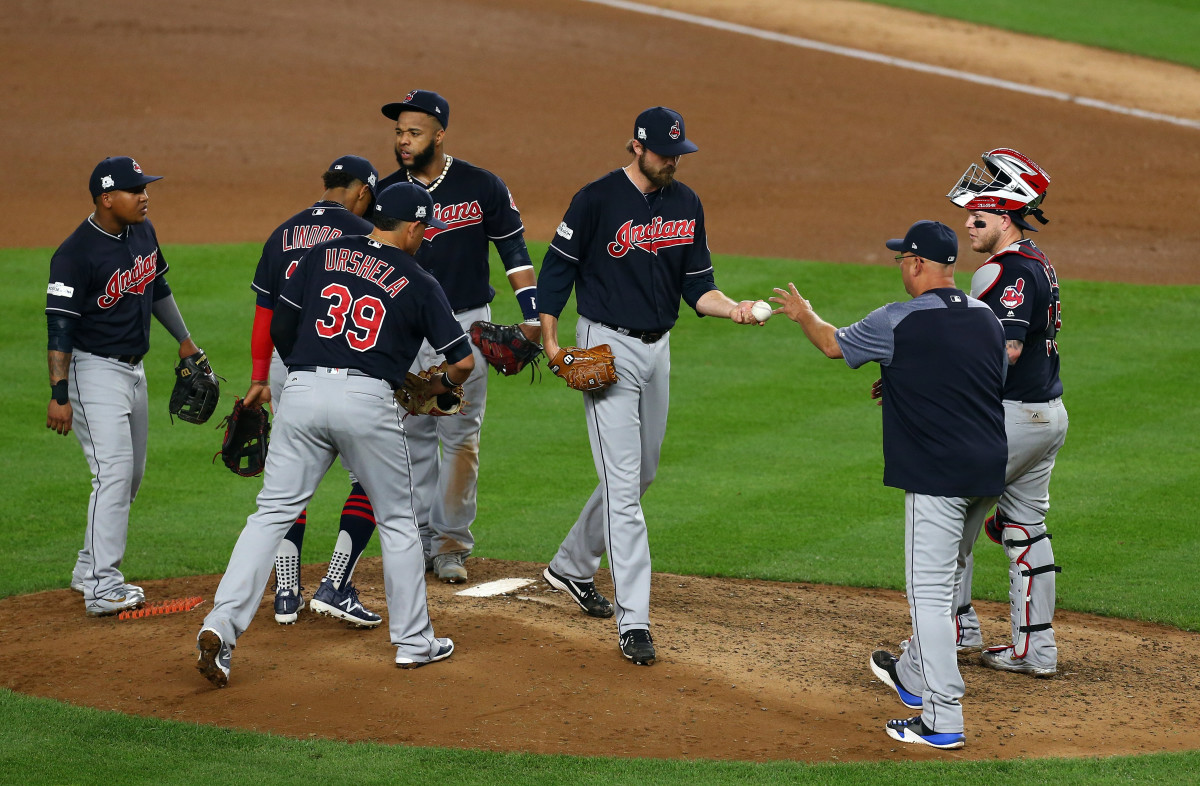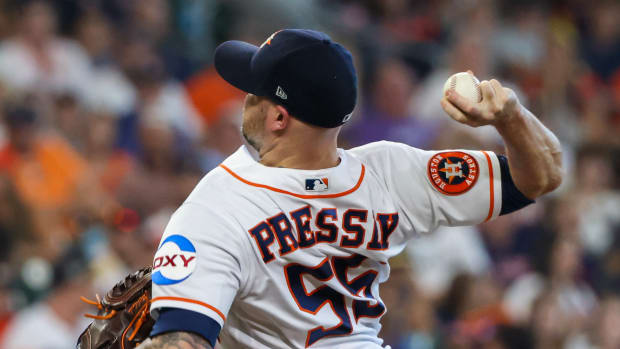History Stings Indians, Andrew Miller in Excruciating Game 3 Loss to Yankees
NEW YORK — The painful losses start to pile up like cordwood. To wear an Indians uniform is to wear a history of despair, just as it had been to wear a Red Sox jersey or a Cubs cap before the baseball gods said, “Enough.”
Francisco Lindor was three years old when Tony Fernandez booted a routine grounder and Edgar Renteria whistled a hit just past the reach of Charles Nagy. He had nothing to do with that Game 7 loss to the Marlins in the 1997 World Series, but he inherited it when the Indians drafted him in 2011. Life, and the weight of what is bequeathed, can be unfair.
Starting with that night in Miami, the Indians have played 20 games with a chance to clinch a postseason series or wild card game. They have lost 16 of them.
Four and 16.
Following the collapse in Miami was the 1999 ALDS disaster against Boston: three straight failed clinchers by a combined score of 44–18. Another Boston massacre happened in the 2007 ALCS: clinching losses in triplicate again, this time by a 30–5 thrashing.
Despair in multiples of three occurred again last year, this time to the seemingly worse off Cubs: losses in World Series games 5, 6 and 7, two of them by one run.
To the pile goes ALDS Game 4 last night at Yankee Stadium: only the third 1–0 postseason loss in Indians history. The slimmest of margins leaves the widest of scars.
Cleveland lost when their ace reliever, Andrew Miller, threw a misguided 1–1 fastball in the seventh inning to New York first baseman Greg Bird.
“The wrong pitch in the wrong spot,” Miller said.
Greg Bird's Exhausting Journey Culminated in One Swing
It was only the second home run Miller allowed to a lefty this year. It was the third time Bird had faced Miller in four days. So it goes in postseason series. The more a specialist like Miller is exposed to a team, the more his edge in uniqueness dulls. We saw it in Game 7 of the World Series last year, when the Cubs had become so familiar with Miller that they knocked him around, including a home run from David Ross because he knew what was coming. By then Ross knew that when Miller shook off a sign with two strikes, “90 percent of the time” he was throwing a fastball. He shook, he threw a fastball, and Ross hit it out.
“That,” Miller said, “is the chess match. Whether (Bird) saw something or changed something only he knows, and I don't think he's going to tell you. You hate to give them a chance.”
Said Bird, “I was trying to stay tight and stay low and stay in my legs and have a good swing, a good at-bat. Other than that, see it and hit it. That’s kind of always been my thing. It's what my mom tells me all the time: see it and hit it.”
Asked if something told him a fastball was coming from Miller, Bird said only, “I saw it and swung.”
The Yankees have dented the hard shells of Cleveland’s two best pitchers, Corey Kluber and Andrew Miller. Maybe it means nothing if the Indians can win behind Trevor Bauer again in Game 4, a game that may be pushed another day if the forecasts for rain are correct.
But as each chance to clinch goes by, the pressure on Cleveland gets ratcheted up.
“Of course you want to get it done today,” Indians shortstop Francisco Lindor said. “We just have to come back and do it tomorrow. We’ve got to focus on playing the game the right way. And score more runs.”
The Indians did not play a bad game. Yankees starter Masahiro Tanaka was brilliant, never more so than in the fourth inning with one out and a runner on third. He escaped by throwing six straight splitters in the dirt, all of which were blocked by Gary Sanchez, the catcher who often uses poor technique behind the plate and opens the door to extra bases. It was an epic show off determination by both of them: Sanchez to keep calling for balls in the dirt and smothering them, and Tanaka by having one after another dive bomb out of the bottom of the zone. The result was strikeouts of Jose Ramirez and Jay Bruce.
Lindor nearly broke the seal on the scoreless game in the sixth with a fly ball to right field that was deep enough for a home run. But 6’ 7” Aaron Judge, with a baby leap, reached over the wall to bring it back. To edit Branch Rickey, height never goes into a slump.
“He told me, “you already got one postseason home run,” Lindor said.
Judge dislodged a section of the padded outfield on his leap. The man who this year hit more home runs in any New York ballpark ever in one season (33) is turning Yankee Stadium into the House that Judge Broke.
Greg Bird's Exhausting Journey Culminated in One Swing
These young Yankees now have faced two elimination games in five days and won them both. They get another one in Game 4, full of energy, confidence and the advantage of their suddenly rafter-shaking ballpark.
The Indians? They don't have their top run producer, the injured Edwin Encarnacion. Their ace and their best reliever have been hit hard. They do have a wily manager and 102 regular season wins to count on. But in Game 4, when they pull on their uniforms to face Luis Severino, they will pull on the wrong kind of history, too.
Four and 16, dating back to Jose Mesa, Tony Fernandez and the worst kind of ninth inning. Two outs from the championship, the lead slipped through their hands, and two innings later so did the game. Not since 1948 have the Indians won the ultimate clincher.
It’s the cruel side of history. Andrew Miller has nothing to do with Jose Mesa and Terry Francona’s Indians have nothing to do with Mike Hargrove’s crew from 20 years ago. But on nights like this, when the difference is one ball going out and one ball pulled back in, the dots of infamy reconnected.




































